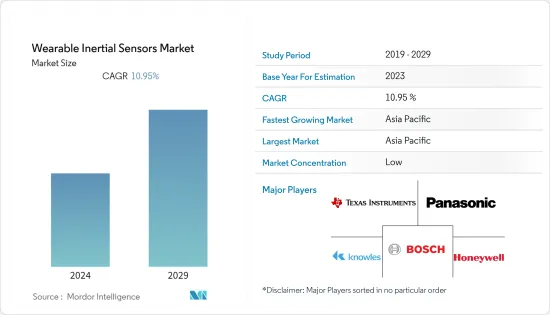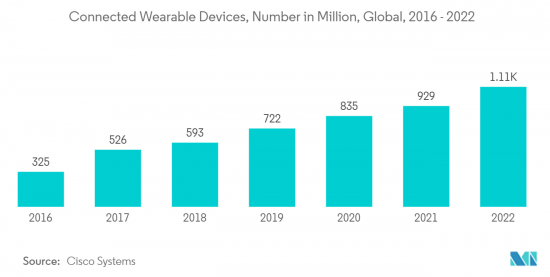PUBLISHER: Mordor Intelligence | PRODUCT CODE: 1404115

PUBLISHER: Mordor Intelligence | PRODUCT CODE: 1404115
Wearable Inertial Sensors - Market Share Analysis, Industry Trends & Statistics, Growth Forecasts 2024 - 2029

The wearable inertial sensors market was valued at USD 629.05 million in the previous year and is expected to attain a CAGR of 10.95%, reaching USD 1.165 billion by the next five years during the forecast period. Wearable inertial sensors, also known as inertial measurement units (IMUs), are electronic devices designed to measure motion-related parameters using one or more accelerometers, gyroscopes, and magnetometers. These sensors are small, lightweight, and can be effortlessly worn by individuals to track their movements during daily activities. Wearable inertial sensors, including gyroscopes, accelerometers, and magnetometers, have developed considerably during the last decade. Through performance, miniaturization, and cost drop, wearable inertial sensors have been integrated into several daily life products, such as smartphones and smartwatches.
Key Highlights
- The fields of application of wearable inertial sensors are numerous. For instance, activity monitoring and fitness tracking are widely employed in the consumer market. Various medical applications based on signal data from wearable inertial sensors have been developed, including fall risk assessment, fall detection, and early identification of Parkinson's disease. According to the Parkinson's Foundation, in 2016, the estimated number of Parkinson's disease patients was around 1 million. This number is predicted to increase to approximately 1.8 million by 2030. Such developments raise the demand for the market studied.
- The rising urbanization across the globe has significantly driven the demand for advanced, aesthetically appealing consumer electronic products that can better serve the consumers' requirements, such as portability, multiple features in one device, and compact and time schedules. Moreover, in recent years, a sizable number of millennials globally has been quick to adopt wearables of different types, including smartwatches, owing to the increased disposable income and the growing penetration of digital solutions.
- Wearables are further witnessing a surge in adoption among the older age population, as most wearable device providers, including Apple, Samsung, and Fitbit, are integrating advanced health-monitoring features that keep them updated about their health status in real time. Considering the growing demand for healthcare wearables, new players are continuously marking their presence in the studied industry by launching innovative solutions, which are also positively impacting the growth of the market studied.
- However, the high cost of wearable products and stringent regulatory compliances across developed regions are challenging the studied market. Furthermore, interoperability concerns owing to the lack of common global standards are also anticipated to remain among the major factors restraining the growth of the studied market.
- The COVID-19 outbreak impacted the growth of the studied market. Owing to the pandemic, the demand for personal health tracking devices increased significantly, driving the demand for wearable devices. With the trend anticipated to sustain in the post-covid period owing to the efforts of the industry players to make these devices as lifestyle products, the studied market is anticipated to witness notable growth in the post-covid period as well.
Wearable Inertial Sensors Market Trends
Consumer Electronics to Witness Significant Growth
- Inertial wearable sensors technology, an emerging trend, integrates consumer electronics into daily activities and addresses the changing lifestyles with the ability to be worn on any part of the body. The trend of wearable inertial sensors in the consumer electronics industry is driven by the factors such as internet connectivity and enhanced data exchange capabilities, enabling seamless communication between devices and networks.
- The growing advancement and reduction in the size of sensors, especially pressure sensors and activators, also exp anded the scope of the wearables inertial sensor market in the consumer electronics industry. As sensors become increasingly bio-compatible, their use for healthcare and fitness activities has also significantly increased. This has led to a significant increase in wearable devices sold over the past few years. According to Cisco, the growth in connected wearable devices, from 835 million devices in 2020 to 1.105 billion in 2022, holds great promise, specifically for healthcare applications. Many compa nies are investing in developing advanced Microelectromechanical systems (MEMS) and digital sensors, further decreasing their sizes and covering a wide range of market applications.
- The micro-electro-mechanical sensors (MEMS) and accelerometers are used for electronic stability control and airbag deployment. Inertial Measurement Units or IMU (they are a combination of MEMS Accelerometer and MEMS Gyroscope) have been developed for wearables as technology has advanced and are influenced by the impact of consumer electronic devices being used daily, such as global positioning system (GPS) or inertial measuring unit (composed of accelerometer, gyroscope, and magnetometer) sensors. This has helped fitness-tracking wearables revolve around these sensors exclusively.
- For instance, Nintendo Switch Labo edition Joy-cons possess default sensors in the accelerometer and gyroscope, usually in electronics consumer wearables. Joy-cons and cardboard combine to build artificial wearables, such as robots, to apply to a gaming function. It is usually Nintendo's way of breaking barriers for future generations (who are more involved with technology at younger ages) in immersive experiences with simplified custom wearable tech.
- Accelerometers are motion sensors, used in wearables. Their brand of acceleration, such as gravity and linear, demonstrates their sensing capabilities. Meanwhile, their measuring ability enables the programming of measured data for different purposes. For instance, a user who runs can access their top speed output and acceleration. Further, accelerometers can track sleep patterns like smartwatches and wristbands, thus driving the demand for wearable motion sensors in the consumer electronics segment.

Asia Pacific to Dominate the Market
- The Asia Pacific region is expected to witness notable growth during the forecast period owing to a large consumer base with a growing penetration of wearable devices and digital technologies. Considering the prospects, OEMs are also creating considerable support toward the enlargement of IMUs (inertial measurement units) and MEMS technology further to enhance the penetration of the newly developed products. Furthermore, the evolution of the electronics industry, owing to the emergence of countries such as China, Taiwan, etc., also contributes to the growth of the studied market.
- The market for wearable inertial sensors has become one of the largest and fastest-growing in China. Smartwatches, fitness trackers, virtual reality (VR) headsets, and motion-capture suits all use wearable inertial sensors, which are sensors that can detect motion and direction. The rapid growth of the wearable inertial sensor market in China has been primarily fueled by the country's rising acceptance of wearable technology and its expanding population of health-conscious individuals.
- The growing popularity of wearable technology and rising demand for measuring one's health and fitness have both contributed to the enormous rise of the wearable inertial sensors market in India in recent years. Wearable inertial sensors, such as accelerometers, gyroscopes, and magnetometers, are essential for giving wearable devices information about motion and orientation, which makes them popular for customers, athletes, and healthcare professionals in the nation.
- Japan's technologically proficient environment and a society that values convenience and innovation has propelled consistent growth in the wearable inertial sensor market there. Wearable inertial sensors have several uses in the healthcare, sports, entertainment, and gaming industries, among other fields. The use of wearables with inertial sensors for monitoring and enhancing general well-being has been accelerated by Japan's aging population and a strong focus on health and wellbeing.
- Due to the nation's tech-savvy population and keen interest in wearable technology, the South Korean Wearable Inertial Sensors Market has rapidly expanded in recent years. Smartwatches, fitness bands, virtual reality headsets, and other wearable medical equipment all feature wearable inertial sensors to some extent. Due to the rising emphasis on entertainment, health, and fitness and the adoption of advanced technologies, the demand for these gadgets has increased in the South Korean market.
- The Rest of Asia Pacific's inertial sensor market, which includes nations like Singapore, Australia, Malaysia, and others perceiving demand for wearable sensors in the Rest of Asia Pacific, has been steadily increasing over the past few years, driven by a growing interest in fitness and wellness, a rising aging population, as well as advancements in technology and healthcare.
Wearable Inertial Sensors Industry Overview
Investments in research and development, along with partnerships and alliances, are expected to be some of the strategic focus of vendors operating in the market. In addition to this, investment into technological innovations and market expansions via strategic alliances are expected to be focal points for the vendors in the market. Access to distribution channels and the deep clientele is significantly higher for large vendors operating in the market. In addition to this, vendors tend to focus on expanding their capabilities in the market via partnerships and acquisitions. Overall, the competitive rivalry is expected to be high among the vendors. Some of the major vendors in the market are Texas Instruments Incorporated, Panasonic Corporation, Bosch Sensortec GmbH, Knowles Electronics, Honeywell International Inc., etc.
In January 2023, Quadric and OSRAM established a collaborative partnership to create integrated sensing modules that combine the cutting-edge Mira Family of CMOS sensors for visible and infrared light with Quadric's cutting-edge Chimera GPNPU processors. The integrated ultra-low power modules will make it possible for wearable technology to use new types of smart sensing.
In December 2022 , Analog Devices Inc. collaborated with Oregon Health & Science University (OHSU) to develop a smartwatch that detects vital mental health indicators to help address the rising mental health crisis in teens. As per the collaboration on the first and one-of-a-kind project, OHSU would leverage ADI's innovative technology and products for the burgeoning worldwide mental health crisis to save, improve, and enrich human lives.
Additional Benefits:
- The market estimate (ME) sheet in Excel format
- 3 months of analyst support
TABLE OF CONTENTS
1 INTRODUCTION
- 1.1 Study Assumptions and Market Definition
- 1.2 Scope of the Study
2 RESEARCH METHODOLOGY
3 EXECUTIVE SUMMARY
4 MARKET INSIGHTS
- 4.1 Market Overview
- 4.2 Industry Attractiveness - Porter Five Force Analysis
- 4.2.1 Bargaining Power of Suppliers
- 4.2.2 Bargaining Power of Consumers
- 4.2.3 Threat of New Entrants
- 4.2.4 Threat of Substitute Products
- 4.2.5 Intensity of Competitive Rivalry
- 4.3 Impact of COVID-19 and Macro Economic Trends on the Industry
- 4.4 Technology Snapshot
5 MARKET DYNAMICS
- 5.1 Market Drivers
- 5.1.1 Increasing health awareness
- 5.1.2 Growing Demand for Wearable Fitness Monitors
- 5.1.3 Rapid Technology Advancements
- 5.2 Market Restraints
- 5.2.1 Security concerns
- 5.2.2 High cost of the devices
6 MARKET SEGMENTATION
- 6.1 By Product Type
- 6.1.1 Smart Watches
- 6.1.2 Fitness Bands/Activity Tracker
- 6.1.3 Smart Clothing
- 6.1.4 Sports Gear
- 6.1.5 Others
- 6.2 By End-user Type
- 6.2.1 Healthcare
- 6.2.2 Sports and Fitness
- 6.2.3 Consumer electronics
- 6.2.4 Entertainment and Media
- 6.2.5 Government and Public Utilities
- 6.2.6 Others
- 6.3 By Geography
- 6.3.1 North America
- 6.3.1.1 United States
- 6.3.1.2 Canada
- 6.3.2 Europe
- 6.3.2.1 Germany
- 6.3.2.2 United Kingdom
- 6.3.2.3 France
- 6.3.2.4 Rest of Europe
- 6.3.3 Asia Pacific
- 6.3.3.1 China
- 6.3.3.2 India
- 6.3.3.3 Japan
- 6.3.3.4 South Korea
- 6.3.3.5 Rest of Asia Pacific
- 6.3.4 Middle East and Africa
- 6.3.4.1 United Arab Emirates
- 6.3.4.2 Saudi Arabia
- 6.3.4.3 Israel
- 6.3.4.4 Rest of Middle East and Africa
- 6.3.5 Latin America
- 6.3.5.1 Brazil
- 6.3.5.2 Argentina
- 6.3.5.3 Mexico
- 6.3.5.4 Rest of Latin America
- 6.3.1 North America
7 COMPETITIVE LANDSCAPE
- 7.1 Company Profiles
- 7.1.1 Texas Instruments Incorporated
- 7.1.2 Panasonic Corporation
- 7.1.3 Bosch Sensortec GmbH
- 7.1.4 Knowles Electronics
- 7.1.5 Honeywell International Inc.
- 7.1.6 TE Connectivity Ltd
- 7.1.7 Analog Devices Inc
- 7.1.8 General Electric Co.
- 7.1.9 AMS osram AG
- 7.1.10 STMicroelectronics NV
- 7.1.11 Infineon Technologies AG
- 7.1.12 NXP Semiconductors NV
- 7.1.13 InvenSense, Inc. (TDK Corporation)
8 INVESTMENT ANALYSIS
9 MARKET OPPORTUNITIES AND FUTURE TRENDS




